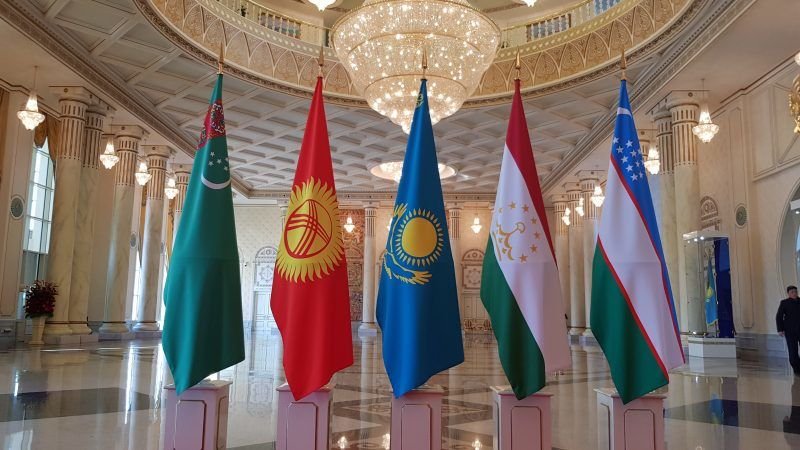Central Asia and COVID 19: Health, Economy, Infrastructure and more

Introduction
Central Asia is one of those landlocked regions of the world which experienced a negligible number of cases surfaced in the region compared to the global average cases is seen with a lot of scepticism rather than a miracle. However, the virus has emerged as a severe challenge not only for the healthcare system but the economy, their migration and a lot more.
Geographical Challenges
The precarious position Central Asia is in as Kazakhstan, Kyrgyzstan and Tajikistan border China, the origin of the virus, in the east; Kazakhstan shares the longest border in the world with Russia, the second-highest country with reported cases, in the north; Turkmenistan shares a long land boundary with Iran, one of the epicentres of COVID-19, in the west; and the three countries in the south – Turkmenistan, Uzbekistan, Tajikistan – border Afghanistan.

The challenge raised by being an immediate neighbour to Afghanistan is a result of the recent peace deal signed between the US and Taliban on February 29, 2020. It opens the possibility of all five countries being affected by the increased outreach of Taliban and other terror outfits residing in Afghanistan, which acts as an additional burden on top of the pandemic.
Leadership
The leadership of the five concerned countries also play a huge role as it dictates how each has dealt with the threat of the virus. There is a distinct difference between the countries with relatively new leaderships compared to those that have not experienced any changes in their leadership for a while.
Kazakhstan, Uzbekistan and Kyrgyzstan have had new leaderships in their governments in the last few years. For instance, Uzbekistan welcomed a new president, Shavkat Mirziyoyev, in 2016. He has been accredited with bringing a revolution from the top as he transformed the domestic political and economic conditions, as well as the situation in the region. These countries have taken a proactive approach in responding to the COVID-19 pandemic and tackling it.
In contrast, Turkmenistan and Tajikistan have not experienced any changes in their leaders in decades and it is evident in the manner they have handled the pandemic. Both the countries have refused to recognise the existence of COVID-19 and consequently, have not attempted to adopt practices such as isolation, quarantine or social distancing. Only recently, in the month of May, have the countries started making some efforts to acknowledge the situation and take some actions accordingly.
Energy-based Economy
There are three countries that are rich in mineral resources, in particular, energy fossil fuels. For instance, Turkmenistan had the fourth-largest reserves of gas in the world. However, even before the COVID-19 pandemic, problems had arisen as Russia and Saudi Arabia had engaged in an oil price war which had resulted in the prices of oil coming down drastically. The worsening prices were further exacerbated by the outbreak of the pandemic. Moreover, the situation deteriorated further as the market for these resources, especially for Kazakhstan, is the Russian Federation which is going through a recession. Similarly, Turkmenistan supplied the majority of the gas to its neighbour China who, at the beginning of the pandemic, invoked the force majeure clause which indicated their suspension of gas contracts.
Remittances
Tajikistan, Kyrgyzstan and Uzbekistan are heavily dependent on remittance of workers and professionals who are employed abroad, mostly in Russia and Kazakhstan. For instance, 30-40 percent of GDP of Tajikistan and Kyrgyzstan is comprised of remittances sent from these countries. Therefore, their economies have taken the brunt as the remittances have stopped and the workers are coming back amidst high unemployment rates,

The Situation in Kazakhstan
Kazakhstan’s Ambassador to India, Yerlan Alimbayev, have acknowledged how the pandemic has been a difficult time for all the people as some have lost their incomes and jobs, whereas others have had their lives completely disrupted. Speaking in a webinar by Ananta Aspen Centre, New Delhi he highlighted the steps his country has taken to tackle problems arising from the pandemic and how it has become the leader in the region in heading the COVID-19 response.
The Kazakhstan government has taken a great number of actions to protect their citizens from the virus and to help them overcome the economic challenges caused by the shutdown. In doing so, the government has received positive reviews from the World Health Organisation and other international experts.
On March 16, President Kassym-Jomart Tokayev declared a state of emergency which lasted till the 11th of this month. They introduced tough measures such as suspending public transportation, organisations and institution switched to remote operations, and residential areas and streets were regularly disinfected. But despite the relaxations in the shutdown, the strict quarantine rules still stay in place. Efforts have largely worked as the virus has not grown exponentially in Kazakhstan as it has in the other parts of the world.
President Tokayev has taken several steps to ensure social and economic stability, and to provide citizens with basic needs. Infected citizens have received the care they needed in a timely manner and the government has emphasised financial assistance to medical workers.
According to the Kazakh Ambassador, the government’s utmost priority is to ensure that no one is left behind. They have given financial assistance to around 5 million people, distributed food and household products to one million people, reduced prices of utilities, deferred loan payments of 2 million citizens and 11.5 million SMEs, and have granted the uninsured citizens the right to receive assistance from Social health Insurance Fund till 1st of July this year. In addition, the state initiated a campaign to help those in need. The ambassador said that as of yet thousands of women have benefitted from the program. An employment road map has also been designed which has provided incentives to more than 700,000 companies and individual entrepreneurs to help them through the crisis. Moreover, President Tokayev has highlighted his support for the agricultural sector as he has allocated more than US$200 million to support small farms, while also reducing fuel and diesel prices by 15 percent for agricultural producers.
The ambassador further discussed how Kazakhstan was focused on humanitarian relief as it was working on providing food and supplies to neighbours. He also shared how despite the general economic slowdown in the world, Kazakhstan has done well and has shown positive trends across all industries such as a 3.4 percent increase in output from the mining sector. Ambassador Sajjanhar called attention to the fact that Kazakhstan’s unwavering economy could prove to be a boon to Central Asia as it accounts for more than 60 percent of the region’s GDP.

The Situation in Uzbekistan
Professor Sanjay Kumar Pandey, one of the most eminent voices from India on Central Asia, in the same webinar, highlighted how a doubly landlocked country such as Uzbekistan which boasts of the largest population in the region of 33 million was dealing with the pandemic.
Uzbekistan has also been the most effective in handling the COVID-19 outbreak as in the month of March it stopped certain flights and instructed its citizens to work from home. They had also introduced measures similar to those in Kazakhstan. Whilst they received some criticism for the stringent regulations, it can be said that they have been efficient in containing the spread of the virus in the country. The country has recorded around 3000 cases yet but mortalities are still relatively low as they number around thirty. There have been debates that the low figure might be a result of their unreliable methods of counting deaths rather than a result of good management.
President Shavkat Mirziyoyev of Uzbekistan had announced the partial reopening of the economy in the second week of May. More than 10,000 industries of around 14,000 in total were closed down leaving more than 17 million unemployed during the lockdown. According to some estimates, the negative impact on the GDP growth of the Central Asian Region will be around 5 percent. In Uzbekistan, it will be upwards of 4 percent. The country has come out with a number of large packages and funds to help revive the economy.
The Situation in Turkmenistan
In contrast, Turkmenistan is yet to announce a single patient of COVID-19 despite the fact that they share a border with Iran, a country with a very high number of cases. Turkmenistan throughout the pandemic has chosen to show instead how they are in control as they had a bicycle run in April to celebrate World Health Day, and on 9th of May, Turkmenistan held a large parade and procession to celebrate their Victory Day. Nevertheless, Turkmenistan has taken various steps to combat a pandemic whose existence they refuse to acknowledge.
Beginning from the end of January, the country stopped flights from certain countries and in March, they made the decision to stop the flights from almost all the countries. They placed strict restrictions on anyone entering the capital as they only allowed entry to those with a doctor’s certificate. Only just in May, the government has started restricting the movement of people and public gatherings around the country.

Relations with China
Kazakhstan and China are strategic allies. As a linchpin of the Belt and Road Initiative, Kazakhstan hopes to resume the fifty-plus projects they are involved in, with China, as soon as the conditions permit. Their good relations are based on the many investment opportunities, political understanding and the quality cooperation they share in the international arena. Kazakh Ambassador believes there will be no changes in their trajectory of diplomatic relations.
India’s involvement
India’s engagement in the Central Asian Region carries high importance of pharmaceutical and medical sector as an area of cooperation as well as educational cooperation that has a lot of promise as Uzbekistan hopes to develop their IT infrastructure which is a field India can help with. There are already Indian universities in the region such as Amity University and Sharda University, and hopefully, there will be more as well. Similarly, India’s trade relations with Kazakhstan, especially the imports of crude oil and uranium are vital and governments are required to focus moreover these areas to shape their shaking economies due to the pandemic. India-Kazakhstan Inter-governmental Commission meeting has also postponed which was supposed to be held this year.
Conclusion
In the region, countries which went into a strict lockdown or a state of emergency have fared better than their counterparts. The only outliers are Turkmenistan and Tajikistan who have refused to recognise the threat of COVID-19 throughout most of the pandemic. Just the mention of the virus was outlawed in Turkmenistan who took actions against the offenders and Tajikistan continued to have large public gatherings well into May. However, it seems like both the countries are coming around now and might be ready to take the outbreak more seriously.
Overall, there has been a positive response in the region which is vital as Central Asia has been extremely significant in terms of security, stability and economy. It is important to India as it forms a part of its extended neighbourhood, but it is also important to the rest of the world. The significance of this region is going to increase further as the Taliban’s prominence will rise. A close look at this region is very necessary. In addition, there are great opportunities for India to engage in partnership and collaboration.
Excerpts: The above excerpts are part of the Ananta Aspen Centre’s webinar titled “Central Asia and COVID 19: Health, Economy, Infrastructure and more”
The Key speakers include Ambassador Yerlan Alimbayev of Kazakhstan and Professor Sanjay Kumar Pandey from Centre for Russian and Central Asian Studies, School of International Studies, Jawaharlal Nehru University, New Delhi
The discussion commenced with brief observations of the region by the chair, Ambassador Sajjanhar.


















